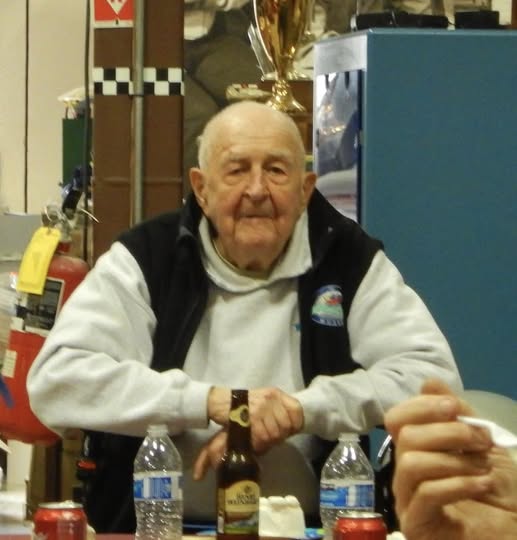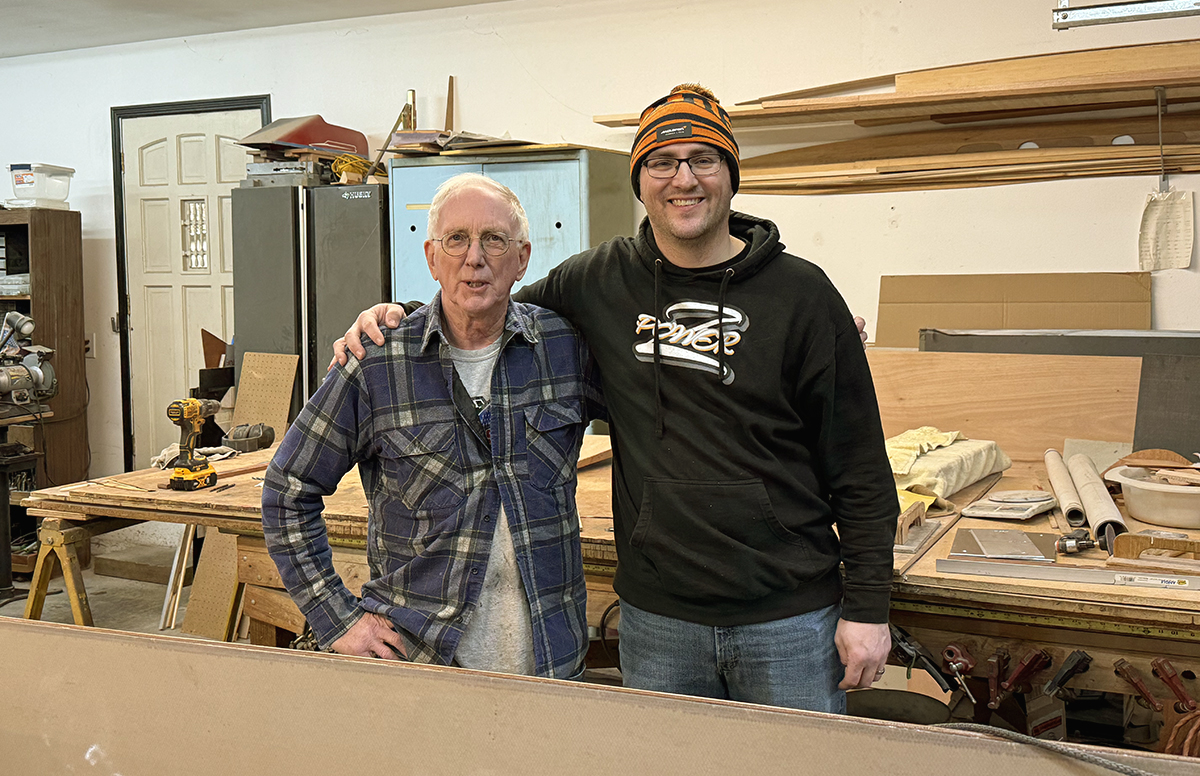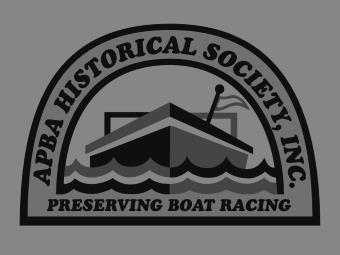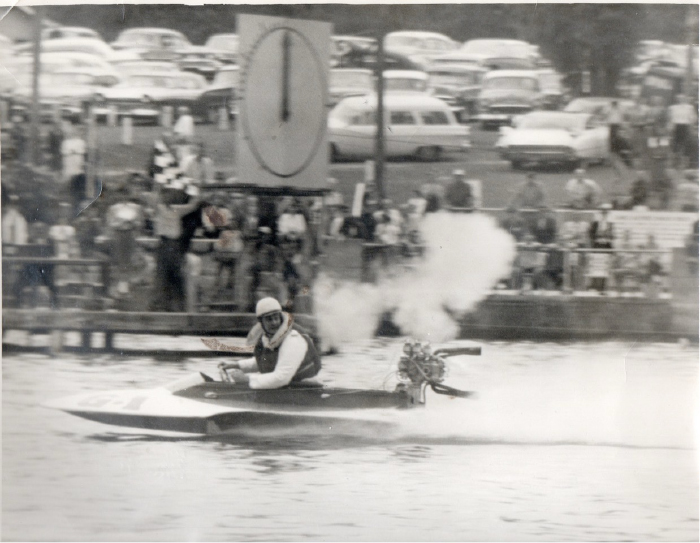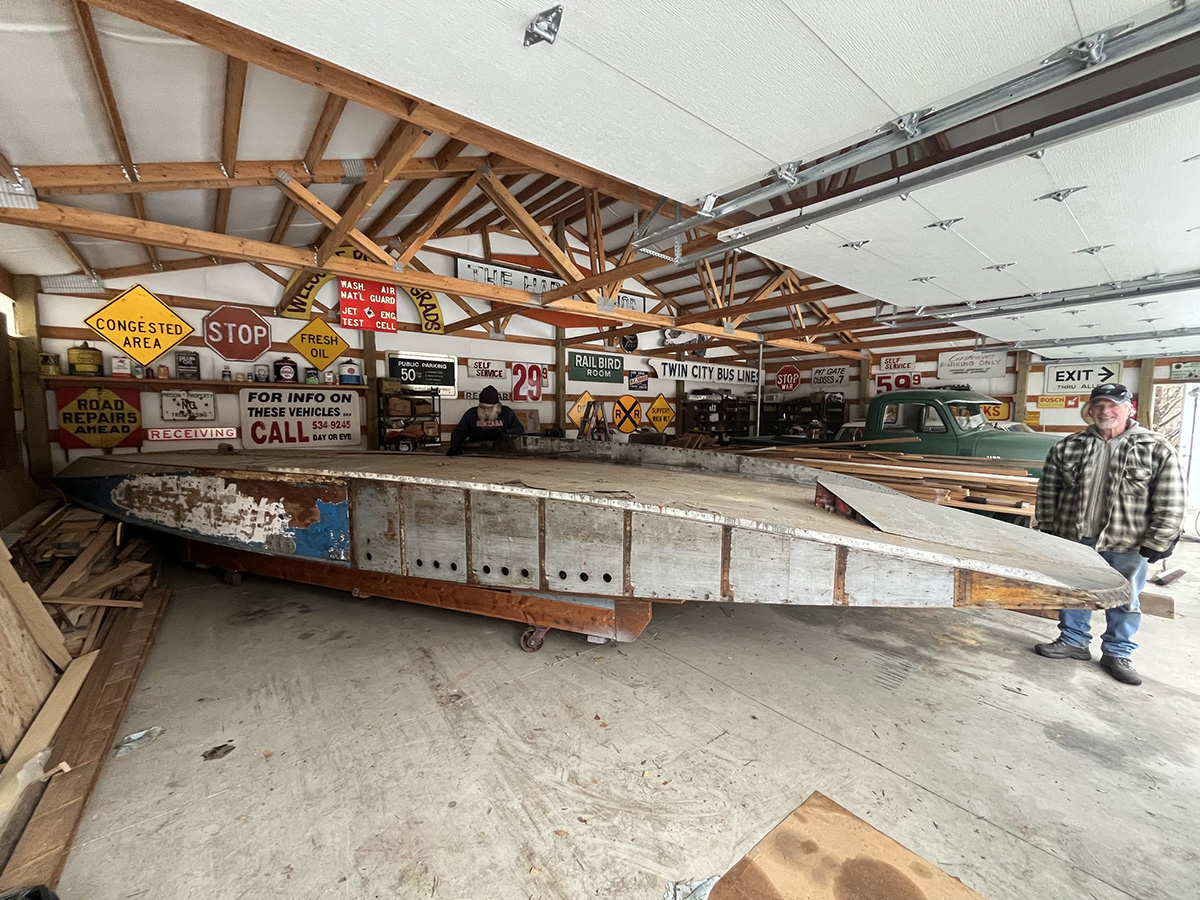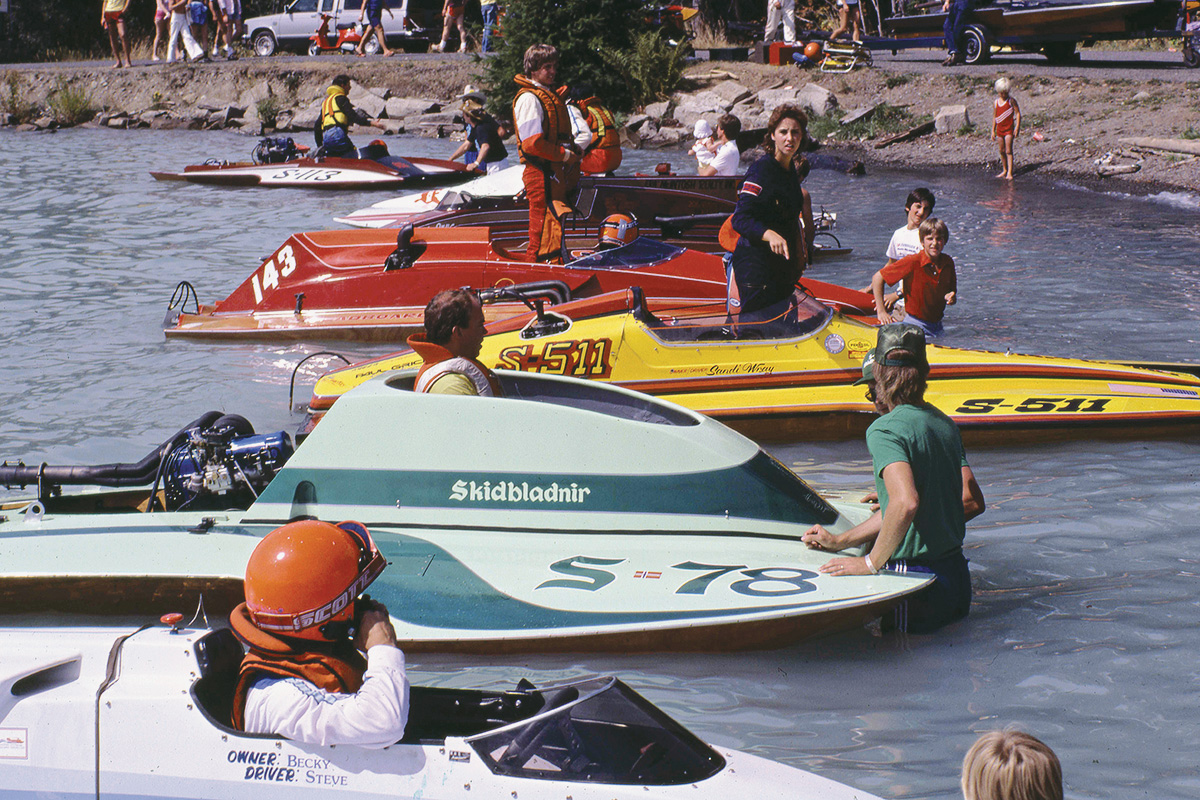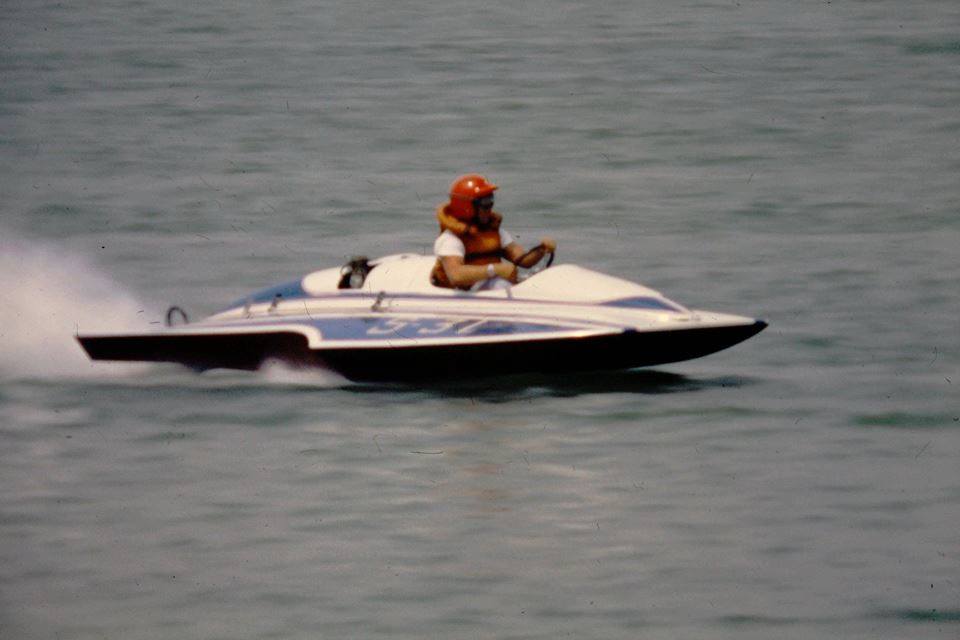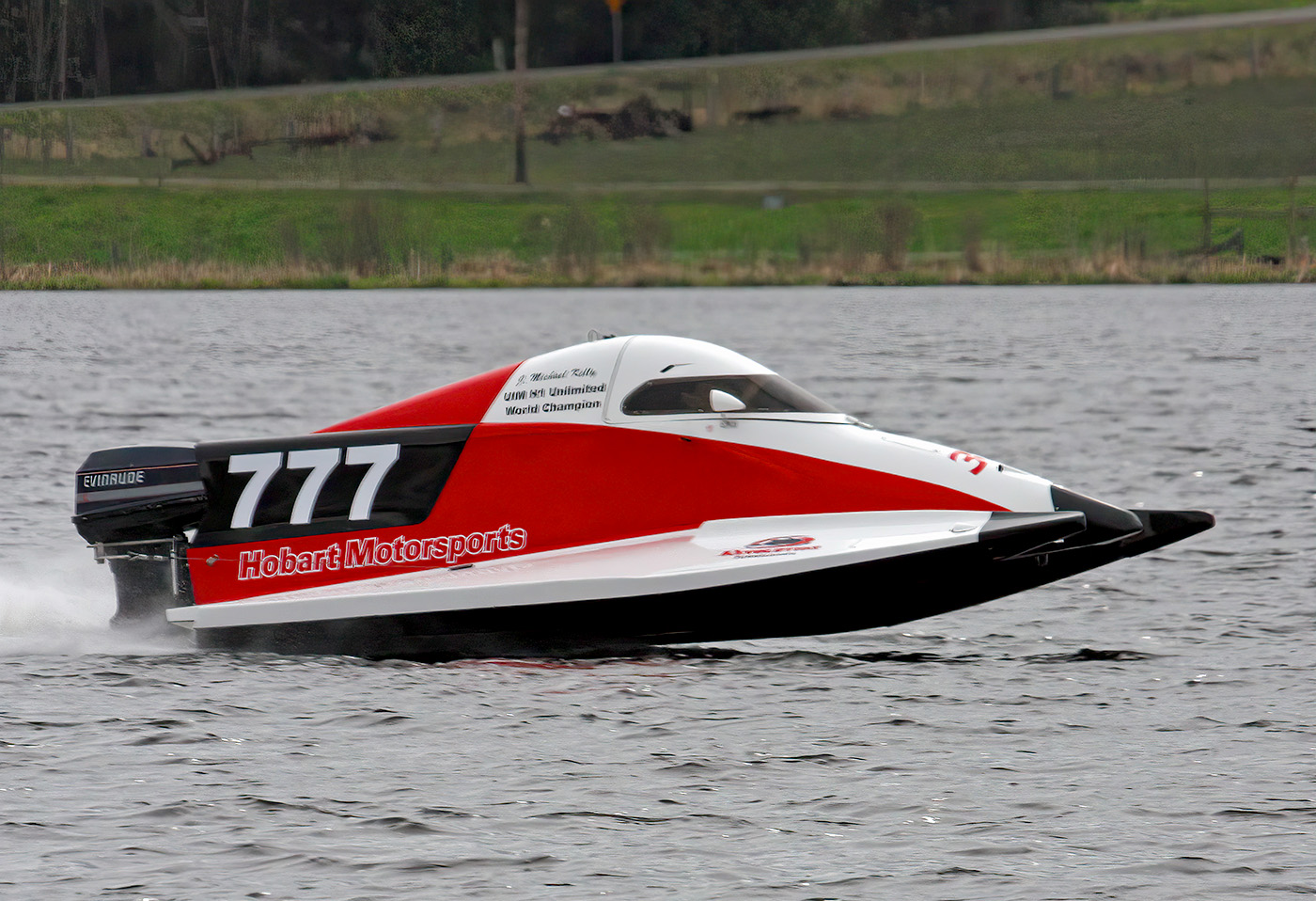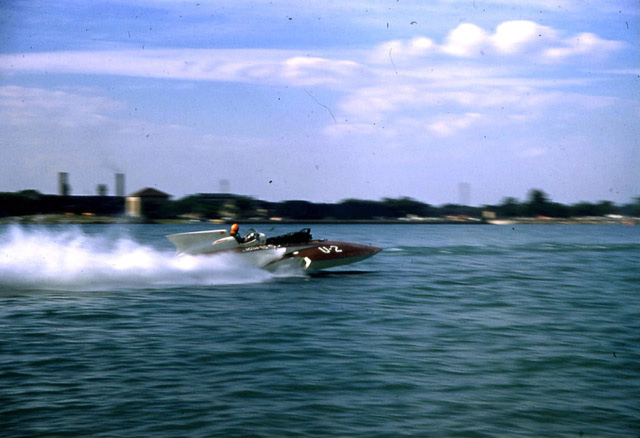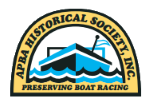A Boatbuilder Shares His Memories: Part Two
July 27, 2022 - 11:59pm

John Prevost’s 7 Litre SHAZAM. Photographer unknown.
In part one of our interview with Ed Karelsen, he reviewed his entry into boat racing in outboard classes and his early experience with boatbuilding. In part two, Karelsen remembers some of the successful inboards he built and the people who drove them. The interview was conducted on January 31, 2012, by Craig Fjarlie.
You mentioned that you drove an inboard once, but you designed and built a number of successful inboards.
Yes, like the 7 Litre. We were running the 427s (427 cubic inch engines – Ed.). John Prevost had only had one heat in it when we built his boat and went to St. Pete. It took him all weekend to get it running, but we made it in the final heat. The 7 Litres—those big Staudachers, which were fabulous—were running about 132, 133 down the chutes. Prevost was reading 146 down the chute. The kilo record was 140. That qualified us for the kilos, so we went to Modesto. He’s the luckiest boat driver and owner I’ve ever worked with. If I tried it, something would’ve broken. So we go to Modesto and it’s three bluebird days (good for racing, with low wind). With only 17 boats, you could run any time you wanted, so John could get used to the boat. It had an adjustable strut. (Under the boat where the driveshaft is supported as it exits the hull, the strut could be adjusted when the raceboat was out of water on a trailer—a revolutionary concept!) We took it down a whole inch, or 7/8 of an inch so he could go through the kilo. (It made the boat more stable at high speeds.) Just like that—I got a picture of it. He was really going. This was in Region 6, and it’s beautiful. You could hear him shuttin’ off the engine at the far end, and we did 148 MPH. I said, “Oh, hell, let’s go out again, we’ll go 150.” He told me, “Twenty years ago I could’ve done that. But to hold my foot in this thing all the way through, a whole mile one way, a whole mile the other way, I just don’t have the guts to keep my foot in it that long. If any of you guys want to try it, go ahead.” So we set it at 148 MPH. Good thing there was another racing team there, and they really ran well. Mr. Moshere and his son Brad from Federal Way, Washington, went 160 with their 7 Litre. I ran into the old man last year at Black Lake. They finally chased him out ‘cause they couldn’t beat him. He told me, “It’s the first boat race I’ve been to in years since they chased us out.” So he changed the rules. His 225 and 7 Litre were unbeatable. Mike Hanson built those. I hired him to help me down at Jerry Zuvich’s shop in Ballard, with all the Grand Prix boats I had on order. I built some more here at home afterwards. The lawn mowers were making more money than we were. I had Zuvich rebuild an engine for a friend of mine—Jerry Miltner from the Cashmere, Washington area. I don’t know if you remember him.
I remember the name.
His boat was a 225 instead of a 280. Same boats. Only difference between a 225 and a 280, is that 225s average less air traps (shallower sponsons) because the engine’s so light. Anyway, he blew the engine up twice and said, “To hell with it.” I said, “I’ll do something with it.” So, I built him that 7 Litre. We had a small block, fuel-injected Chevy in it. They would turn 9,500 RPMs. I tested it at Black Lake (near Olympia) with the first three-blade propellers we got from Mercury. We took the gearbox and turned it over (lowered the gear ratio to give more power to run a higher pitch propeller), ‘cause it was a 24-inch (pitch) wheel. He never went so fast in his life. He comes through the corner right in front of the pits and went to turn it. It went three leaps on its nose and spun out. Well, I found out why. For the number of blades, we used to run ‘em what we called downhill. The strut was deeper than the sponsons. Everybody measures ‘em different, but I had a cross-reference for your bottom, and then your lift angle, whatever it is, and this is zero. So when your sponsons come down, let’s say they’re four inches deep. Well, the back of the strut is four inches deep. With the old two-blades, we were 4-¾ inches deep. That’s the way we found that out. I built two of those—that one, and one for Prevost. That was his first 7 Litre. Anyway, that boat won J National Championships and set records at Black Lake, I think, two or three times. Then I built him that black one. He wanted a bigger boat to use for Grand Prix and 7 Litre. I told him, “Either way, you’re at a disadvantage for both classes.” Well, he only ran it once. His son was back at Dayton, Ohio, for the Stock Outboard Nationals. The following week was the Inboard Nationals. So John stayed, worked all week on that thing to get it running. Prevost had never even been in the boat before and he won both heats. But they called him for sawing somebody off going into the first turn, so he only had one heat. He could’ve won the Nationals with it. I built him another one. He wanted a smaller boat just for records. I didn’t think too much of the idea, a 20-foot boat. I said, “Naw, let it go.” Anyway, at that time, after I finished that boat, he didn’t run it for three years. When he was going to run it, I flew down to Baton Rouge. We dyno’d up the engine—wasn’t ready. Worked a whole week on it. Finally we got it running around 2:00 in the morning. The next thing you know, we gotta be in the pits. And then I tell him if he shows up late any more – Prevost always was late for everything, even airplanes, he’d be lucky to make his airplane flight – anyway, they told him if he misses the drivers’ meeting to turn right around and go home, ‘cause they ain’t gonna let him run any more. Everybody on the East Coast was fed up with him coming in late all the time. He says, “Aw, hell, we’re not gonna go.” I said, “Wait a minute, I’ve been here working all week, I want to go. Let’s go. I want to see all these new Staudachers.” So we talked him into it. Called his crew and him and me and his son, and we got this van off the lot and went to St. Pete. Well, they had a whole fleet of new Staudachers and they were all faster than hell. Must’ve been 15 of ‘em there. They raced two days and every time one of ‘em broke out front he raised the record higher. I looked at it. Jim Kropfeld, who was driving the Budweiser Unlimited hydroplane, was running one of ‘em, too. He had two big pieces of lead out on the pickles ‘cause he was afraid he was going to blow it over. He comes in, he says, “All these guys, I thought they were all my friends. They sawed me off in the corner.” I said, “Well, yeah, you’re the Budweiser driver. Your buddies all want to drive the Budweiser.”
I told Prevost, “That boat you’ve got in the shop, you can forget it. I’ve got an idea for a new one. I’d like to build it.” He says, “I ain’t got any money.” I said, “I’ll take that old Dodge I’ve been driving for the boat.” He said, “I sold it to Mashburn (a driver from back East).” I said, “You’re a Dodge dealer, and you only have one car?” So I traded Mashburn the car for the boat. Prevost really made it go. He raced it for a year. He wanted a real light boat, but it was too light. It was only 1,800 pounds with a 700-pound engine in it. We won the Nationals, but we blew the air trap. We patched it for the second heat, plus his engine was leaking water. Too cheap to buy a new one. Had a cracked block. I asked the crew, “How come we’re using a cracked block?” He says, “Well, I ain’t got enough money to buy a new block.” So we had to go out at the two-minute gun so he wouldn’t fill up the water with oil. Now, if that had been me, he never would have made it two heats. We ran one heat, then we changed all the oil again. It’s half water. You know, bearings don’t like water. I figured he’d never finish three laps. But he did, both of ‘em out front, won the Nationals. I asked him later when we got home, “What did the bearings look like?” He never wiped (ruined) the bearings. He was always lucky that way. Then we took the thing—won at St. Pete, and he won at the Eastern Divisionals, and he was running at the kilos. So he was running four races. When we were at the Nationals, the whole side was cracking. He wanted the boat “real light.” Well, it was. I said, “Don’t run this thing again. Put another sheet of plywood over the aluminum, because you’re gonna blow it all out of there.” He went to a river race—maybe the Ohio River? And he blew the thing out. Blew the deck off. He called me, madder than hell. I said, “I told you at Dayton, don’t run it until you’ve fixed it.” After he settled down, he said, “I never went through a corner so fast in my whole life.” (Laughs.) So they fixed that, and he rebuilt the front and put a capsule in it and everything, so it lasted quite awhile. He was talking to me for two years, wanting me to build a boat, and I didn’t want to do it. I finally told him, “Give Nate Brown a call. Maybe he will build it for you.” Nate Brown knew what he was doing. I say, that boat was the most expensive boat I ever sold, and I gave it to Nate. I told him, “Just copy the rudder that’s on there. Or take the rudder off the old boat and put it on the new boat and see if it’ll work.” Well, he had his own ideas and they wouldn’t work. I went down to Tacoma to see it run, and both sponsons blew off it. The boat never handled; damn rudder didn’t even work. That was the worst mistake I made, and I’m so sorry I did that. Wish I’d built it, ‘cause it was a disaster.
And I did that twice. I built another one—Steve Straith’s boat. I was behind schedule so I gave it to Bob Hering to finish. He was building tunnel hulls for Greg Jacobsen that didn’t work, and that one didn’t work either. Greg likes it anyway, so it doesn’t make any difference. He keeps it as a trophy or something. I built another boat a year later and it’s the same thing, with a 6 Litre. I built it for Grayson Jones, from Maryland. He got a Jersey Speed Skiff before he bought that boat. It’s the first one I built from that model. He took it to St. Pete while I was there and they timed him at 118 MPH on the 5-mile competition course. At the time, the 7 Litre record was only 114 on that course.
And what class was that?
6 Litre. Semi-stock, can’t do too much to it. I was watching him. It looked awful fast, but 118? I wonder if somebody’s got a fast watch, you know, but I was really impressed. He comes in, put it on the trailer, and the rudder’s bent over 70 degrees. He didn’t even feel it. So I told him, “Take the rudder and bracket off and send it to me. I’ll make a whole new one.” The rudder was an aluminum casting and was used on the Champagne Lady. We cracked a couple of ‘em on the Champagne Lady. Jerry Bangs did that. It was all bent over.
That was at Lake Sammamish, right?
Yeah. I told him, “Don’t run the kilos with that boat; you’ll blow the thing over.” It ran really loose. It was a fabulous short course boat, but he almost blew it over at Dayton, Ohio, on the long straightaway. The night before the kilos it was in my shop up on Roosevelt Way. We finished it up and I came home. The wind was blowing like mad; a big storm hit. I went to bed, I said, “Hell, they can’t run tomorrow.” At one o’clock Bangs calls me, “Where’s my boat?” I said, “It’s still in my shop.” He said, “Well, get it. I want to put the engine in it.” Glen Davis and Ed Nelson had finished the engine and they wanted to put it in the boat and go to the kilo. I said, “Bangs, you’re crazy—look outside. Don’t you see the wind blowing? There’s no kilo tomorrow.” But I got out of bed, went and got the boat for him, and said, “Don’t run it until I’m there.” We showed up, they looked at it. Drove it to the pits on the other side—not where they race. We had to put a real high gear ratio in it. We hadn’t even got another gearbox in it and he borrowed a bigger propeller. I said, “Bangs, don’t do that.” He said, “OK, I’ll just go test.” When he put his foot in it way down there at the start of the kilo, both Carver and I knew what was going to happen. Carver put his camera on automatic. This thing went end over end three times. (The boat was said to have gone about 300 feet in the air, running 150-plus MPH.) When it came down, it hit the pickles and flopped on its back. I could see two things stickin’ up off the sponsons. I couldn’t figure out what that was. It had little runners on it. When he hit so hard, the pickles broke off there and bent outward, and that was the aluminum sticking up.
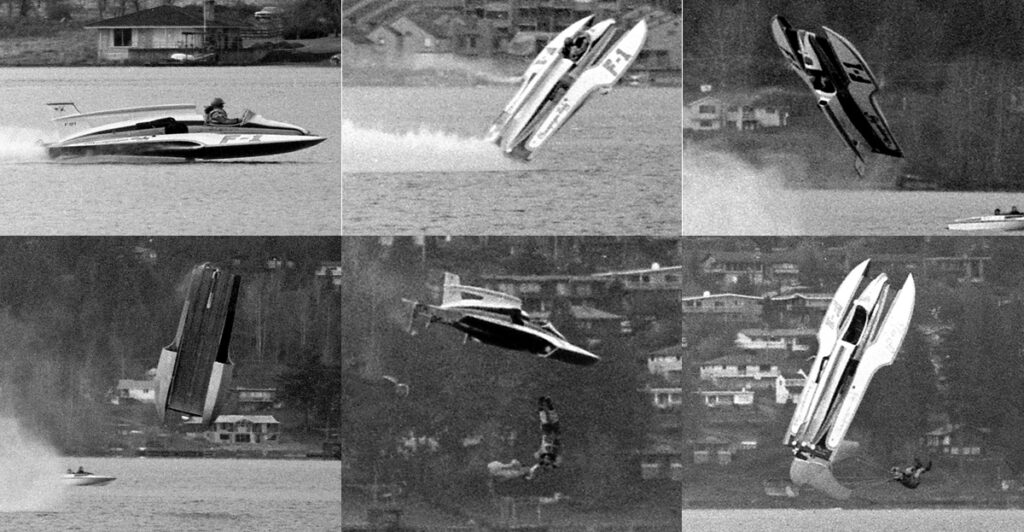 Jerry Bangs’ spectacular flip, captured by Bob Carver.
Jerry Bangs’ spectacular flip, captured by Bob Carver.
Sticking up, wow.
Heh, heh. He had just put a new paint job on it, too. Lanny Lindros painted it over at his shop. Beautiful paint job. Ha, ha! You never put too fancy of a paint job on it; that’s when somebody drives over it or you wreck it. (Bangs survived, with only a broken right foot.) It took us a week to find the boat; Lake Sammamish is 207 feet deep there. Don Due had been skin diving, so he made spot dives and found it, and tied a rope around the strut. It was upside down. Came up with the rope, put it on the boat, took off with it, and it came right up to the surface. They took it back to the resort, slid it up on the beach, and took the engine out. The whole deck was gone. Bangs said, “Take it home, put it in the garage and let it dry out for a couple of months, and we’ll fix it.” So I put it back together. By then he was driving that Unlimited, so he got Terry Turner. The Nationals were here that year. Terry Turner had been doing a good job of driving and Bangs let him drive it. He won the 1976 Nationals going away with it. There was a guy from back east with a Lauterbach that was so fast, he held all the records. He was supposed to have a $50,000 Dodge and really fast. Well, hell, Turner ate him alive. Last I heard about the boat it was sitting out in a field someplace down in Kent. Been out there on the trailer for 20 years. Friend of mine wanted to buy it or something. Well, there’s nothing to buy. Sitting out there for 20 years, it’s a rotten mess. You got plans for it, build a new one. Don’t repair old ones. That was quite a boat, though—won the Nationals with that. (Pulls a photo from a folder.) That other boat wasn’t for Bangs. Here’s another one of my 6 Litres. I sent him a set of plans and he built that.
What was the name of that boat?
Sunday Warning. I got it right off the plans. They ran at Detroit. He beat all the 7 Litres with it, the first day. Finally, Jerry Hopp caught him with that blown engine, right at the finish line, the second day. I guess they’ve built another one now. I said, “Just take the same plans and take the transom back about two feet.”
I had built this 6 Litre in ‘85. The guy who ran it had never raced. He had some of the guys who helped build engines in his crew. The first race he finally got to run was Valleyfield—the only time. It was ‘87. They had something like 28 6 Litres there. An airline pilot came back after the race and said, “This guy shows up—no one had ever seen him before. He almost lapped the whole field Saturday.” He couldn’t believe it. He said, “A little flatter on Sunday. Got in front and stayed there, but no lapping people.” I said, “Well, he wins a National Championship for his first race.” Actually, he was fourth one year. The motor blew up, and he didn’t win that time. But he won all these other championships and no one could beat him.
Who was this?
Grayson Jones.
You worked with the APBA Dream Team.
Oh, the APBA Dream Team. I was the boat builder and they all wanted the most for the Dream Team. Ken Muscatel was buyin’ a 6 Litre. He says, “By golly, I’m the best driver in the country, I have the best boat in the country, the best motor builder, and I go back there and I beat everybody to the first turn.” He says, “Halfway through the turn this white boat out of the corner of my eye, goes right around me and is gone. I’m so damned tired of seein’ those rear sponsons in front of me.” So he went and got Straith’s boat. It doesn’t handle the same. It scares the hell out of me watching it, especially with Muscatel in it.
We’ve heard that before.
Well, he takes it up to Lake Tapps. He leaves the pits, first guy out. Wide open. You don’t take a race boat and go wide open anywhere. These engines, you gotta let ‘em warm up, you treat ‘em gently, especially a high-performance engine. He goes wide open. He goes out, first one out on the course, he goes screaming wide open down the backstretch, comes up there, hits his own wake and swaps ends. They turn right, and the guys and I think, “Oh, my God.” He used to scare me. The guy making his engines for him was a driver, too—flatbottoms. I said, “Why don’t you drive it?” The boat scares me; it never has looked right. But that’s what they do. I’ve had two boats in all of my history that somebody else built, and neither one of ‘em worked. I’ve never bothered to do anything with them. You have to turn them over so I can really see what the hell they did wrong. But, I’m not gonna run it anyway, so it’s a waste of time.
On another subject, your son, John, raced for several years. Do you have anything you’d like to talk about concerning his accident?

John and Ed Karelsen.
I built my son’s his first A for him. I told him, “John, the name of your boat is For Sale. The next one will be better.” He found that out, too. He was running the Calypso 280 class Inboard the same time he was running the 500cc, when he got killed in the 500cc. When we were discussing it beforehand, he said, “I shouldn’t be kneeling in this boat; I should be sitting down.” Actually, we should have been using seat belts even in those boats, given all the accidents I’ve seen. Usually the guy died hitting the water. Three-fourths of the boats landed right side up. See Lauterbach’s studies. He went to the kilos. Tate was going and when his boat blew over, a 2.5 Mod Lauterbach, it went clean over and landed right side up and went up on the beach. And you can see here in a photo of John Karelsen, when it hit the water, it was the biggest splash. And it killed him. If he’d had a seat belt on, he’d have been in the boat when it landed. At St. Pete one year, right in the pits, a boat blew over and flung the driver right out. He was paralyzed the rest of his life. It landed right side up. When you’re upside down, then you’re in trouble. You need the safety to get out of it. Now we have capsules. I think we should have capsules in these things, too.
Yeah, it probably could be done.
Well, they do with the 45SS. They got, what, 45 cubic inch engine? It’s no different than a D Hydro. Like I tell Howard Anderson, “Hey, you got these alky boats, they go over 100 miles an hour. They should have capsules in all of ‘em.” And Howard says, “Oh, God, the guys won’t buy ‘em ‘cause they’re too expensive. Won’t have anybody running.” I said, “You keep doing what you’re doing now you won’t have anybody to run ‘cause they’re all dead.” There’s no reason they can’t design capsules for those boats. I wanted to do that with that D Stock Hydro I built for Larry Oberto that John Peeters has now. He’s a little light guy. I said, “Why don’t we build you a capsule boat?” “Ah, can’t do that, cost me too much money.” Well, I know his dad and his mother. I said, “I’ll bet you if you asked your mother, they’d pay for it.” So he says, “Don’t do that!” (Laughter.) He’s one of the drivers that scared me all the time. I finished that boat for him and I set it up for him and he’s running at Lake Lawrence. I said, “Now, don’t listen to your buddies. They’ll change it. Just leave it alone and run it the way it is and you’ll be fine. You ain’t gonna set any records the first time out in it anyway.” Well, he changed it and blew it over backwards. You know, he’s a nice kid and everything and really enthusiastic, but he scares me. And he’s not the only one that scares me.
Were you there when John was killed?
Oh, yeah. It was real windy. Way too rough. I was telling John to go across to the other side where the cliffs are, ‘cause the wind was coming from the west. We had a brand new Koenig engine. Anyway, he went 10 laps up and down along the cliffs over there, and he came wide open across the lake; and instead of coming in where I’m standing, he hit the turn at, I’d say, 100 miles an hour and he comes through, comes by me. I thought he was coming in and he went back again. This time there were deep holes in the water and it hooked. Hooked and just flung him out, and he hit a wave. Those helmets are almost like running into a brick wall and it did damage to his brain. He was probably dead right after he hit.
He and I had been talking before that. These helmets are all wrong. They’re too heavy. They take your head off if you hit wrong. He said we should have lighter helmets. He went to a group meeting here on the safety committee when they had some of these European helmets that are real light. I had an old motorcycle helmet when I was racing. But they weren’t big and heavy. This stuff we wear now, we should’ve put a cockpit in it and reinforced it. And that was 10 years before they did it.
This is the end of part two of the interview with Ed Karelsen. Next month, in the conclusion of the interview, he remembers his involvement with Unlimited hydroplanes.
###
Featured Articles
